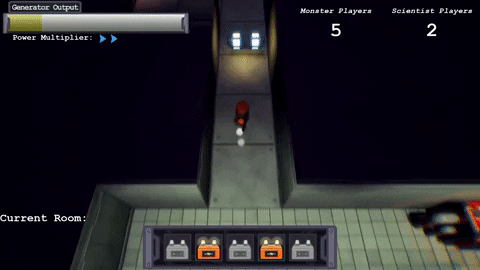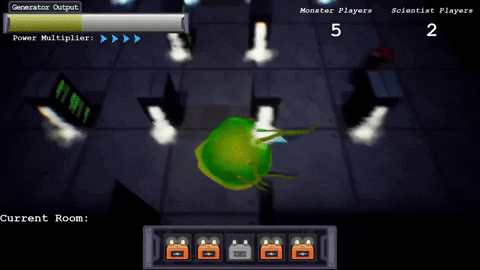Developed in Unreal Engine 4 January 2021 – May 2021
Role: Lead Gameplay & UI Designer Team Size: 8

A Multiplayer, Third-Person, Asymmetrical Action Game

Responsibilities: Documentation, Concept Design, Mechanics Design, UI Design, Balancing
Ubisoft Game Lab Competition 2021 Submission Nominated for “Best Game Design Award
Overview
Escape from the Bodysnatcher is an isometric action game in which players play as scientists within a secret government facility. One of their experiments has breached containment and is on the hunt to absorb all the scientists before they can return power to the facility and recapture the monster. At the beginning of each game, one player is randomly selected to start as the monster and the remaining players start the game as scientists. Once a scientist is absorbed by the monster, players split control of the monster and must work together to hunt down the remaining scientists. The game ends when all the scientists are absorbed or when the scientists can survive long enough to repower the facility.
Development of this game took place remotely for the 2021 Ubisoft Games Lab Competition. The competition featured over 160 students from the US and Canada working on games from 11 different universities. The theme for 2021 was Apart Together. Our team’s interpretation of the theme was to make a game with asymmetric gameplay representing both apart and together. Players in the scientist's role may work towards the same goal but they are working separately to achieve their goal whereas players in the monster role are working together as one entity to chase the remaining scientists.
My Responsibilities:
I was responsible for designing and balancing the gameplay as well as making the game readable to new players. I primarily worked on designing and balancing the goals and interactions of both of the player roles within the game. Since it was an asymmetric game, both roles had to be fun and balanced and followed our design pillars of Apart Together and Maximum Hijinks. This project was developed entirely remote team, communicating via Discord.

Describe your image

Describe your image

Describe your image

Describe your image
Game Features
-
Viscerally fun and engaging gameplay
-
8-player online multiplayer with voice chat.
-
Two distinct player roles
-
Mechanics that reinforce collaboration amongst teammates.
-
Allows for casual or strategic gameplay
-
A maze-like laboratory environment for players to explore
Design Problem #1: Asymmetric Gameplay
When designing the primary game loop for the game, we found that a problem arose fairly quickly. Both player roles must be balanced and equally fun to play in order to make a successful asymmetrical game. Early in development, we found that playing as the monster was a lot more fun for our testers compared to the scientists. This was because the monster had a concrete goal of finding and absorbing the scientists, but the scientists did not have any goals beyond running away from the monster. This was not ideal because it led to players developing a running and hiding playstyle rather than being active participants in the game.
.
The Solution - Scientist Tasks
My solution was to give the scientist players a task to accomplish while running from the monster in order to discourage players from camping around the map. The task that I decided to give the player was to find batteries and carry them to generators that are placed around the map. The batteries and generators spread out across the map encouraged the scientist to explore the environment rather than passively hide. Searching for the batteries caused the scientists to be exposed and use the level more effectively. Exposing the scientist players made playing both roles a lot more entertaining.
In addition to giving the player a more active role in the game, I wanted the game loop of the scientists to contribute to the overall state of the game. When a scientist powers a generator, the game clock starts to count down faster. This affects the scientist and monster equally. Speeding up the game clock means less time for the monster to chase the scientist and less time for the scientist to run away from the monster. Since the location of the generators is a constant between games, gameplay strategies can be formed around knowing when and where scientist players might be. Giving the scientist a more active role in the game changed the gameplay dynamic to be more like tag rather than hide-and-seek

Design Problem #2: Gameplay Readability and Communication
Fairly early on in our development, we found a problem in our game’s readability when playing as the monster. The monster’s movement direction is determined by a weighted average of all the players controlling the monster. As an 8-player game, playing as the monster can become incredibly difficult especially later in the round. We decided to add a voice chat for those playing as the monster so that all the players can communicate with each other and decide how they want to play the game. This was helpful, however, we found that the monster still was pulled in many different directions even with the voice chat. A bit of disagreement from the players in the monster role can create interesting gameplay moments, but the level of confusion we were seeing was causing the game to be frustrating.

The Solution - Monster Directional Indicator
My solution was to give the monster directional indicators so that players could make more informed decisions. Initially, we wanted to have the tentacles on our monster point in the direction of each player’s input. We found that using the tentacles like that was good for seeing each person’s directional input, but made playing as the monster virtually impossible to understand. Instead, we decided to limit the directional indications to two color-coded lines so that each player could only see their own directional input as well as the direction of the weighted average. This was quite effective in showing the player that their input was being recognized but could make gameplay decisions in an instant rather than waiting for a spoken consensus.
Documentation
The Game Design Document (GDD) was reviewed by professional game designers and curated for the project. Working with my co-designer, Gavin Chambers, we worked on this document extensively throughout the project, updating it whenever a value was altered in the engine or planned to be altered as well as when new features were run by the team and confirmed for the feature list for installment to the game.
